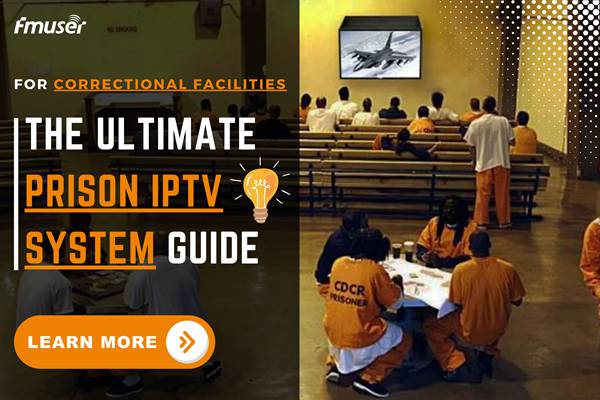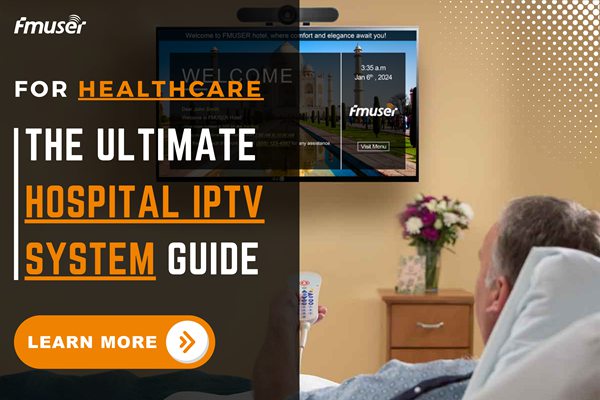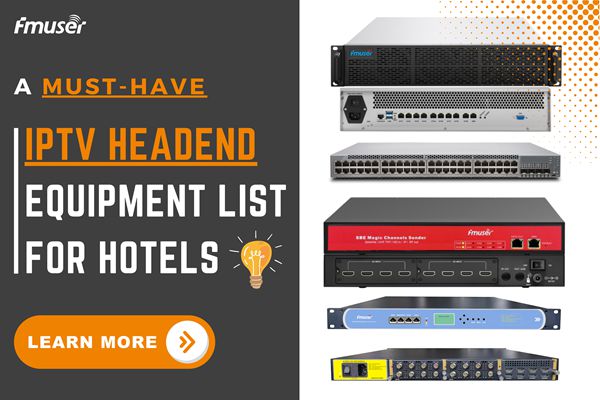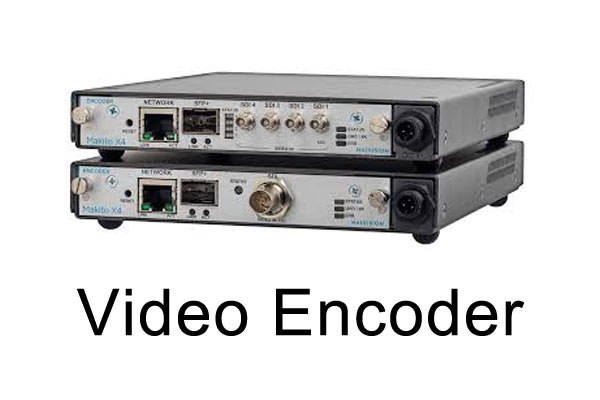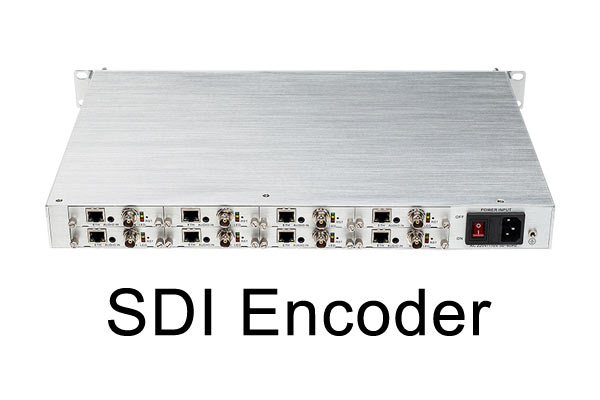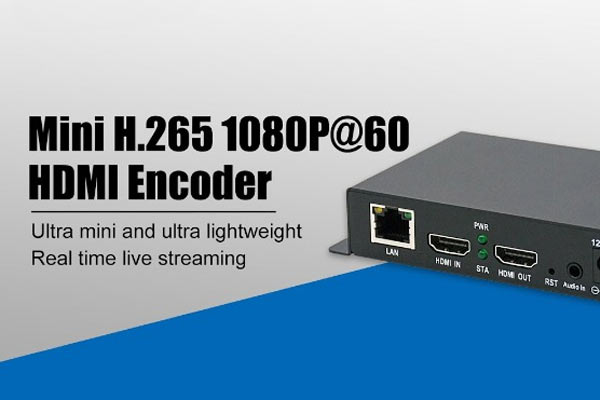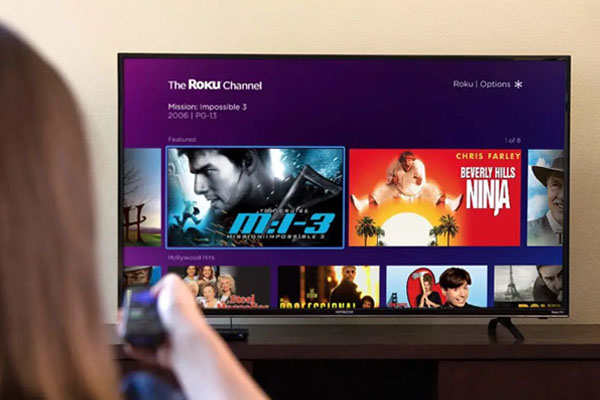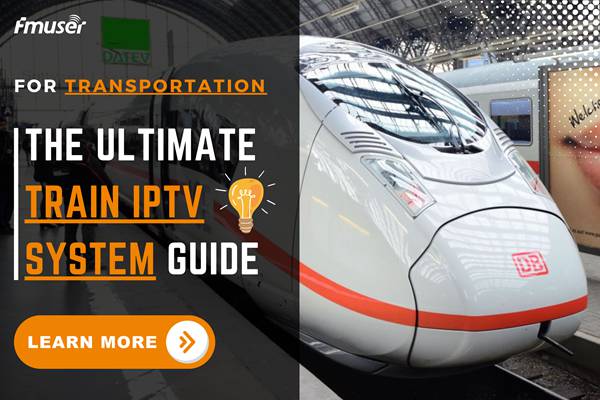
Hot tag
Popular search
The Ultimate Guide to IPTV Systems for School | FMUSER
In today's digital age, schools are embracing innovative technologies to enhance the educational experience. One such technology is IPTV (Internet Protocol Television), which delivers television services over the internet. With IPTV, schools can revolutionize content delivery, communication, and administrative tasks.

IPTV enables schools to provide interactive learning experiences, access a wide range of educational resources, and offer on-demand content. It facilitates campus-wide announcements, live streaming of events, and distance learning opportunities. By integrating IPTV with existing systems, schools can efficiently distribute content, organize resources, and create a more engaging learning environment.
Embracing IPTV empowers students, engages stakeholders, and prepares students for the future. It enhances learning outcomes, fosters collaboration, and creates a connected educational community. With IPTV, schools can shape the future of education by utilizing technology to its fullest potential.
FAQ
Q1: What is IPTV for Schools?
A1: IPTV for Schools refers to the use of Internet Protocol Television (IPTV) technology in educational institutions. It allows schools to stream live TV channels, on-demand video content, and multimedia resources directly to students' devices over the school's network.
Q2: How can IPTV benefit schools?
A2: IPTV offers numerous benefits for schools, including the ability to enhance learning experiences through the availability of educational content, improved communication with students and parents, cost savings by eliminating the need for traditional cable or satellite TV subscriptions, and increased flexibility in content delivery.
Q3: What types of educational content can be delivered through IPTV?
A3: IPTV enables schools to deliver a wide range of educational content, such as educational TV programs, documentaries, language courses, instructional videos, virtual field trips, educational news, and more. This content can be tailored to different age groups and subjects, supporting the curriculum and engaging students in diverse ways.
Q4: Is IPTV for Schools secure?
A4: Yes, IPTV for Schools can be designed with security measures in place to protect student data and ensure a safe viewing experience. Implementing secure network protocols, user authentication, encryption, and content filtering can help safeguard against unauthorized access and inappropriate content.
Q5: How reliable is IPTV for Schools?
A5: The reliability of IPTV for Schools depends on the quality of the network infrastructure and the IPTV solution used. Schools should invest in robust network equipment and work with reputable IPTV providers to ensure a stable and uninterrupted streaming experience for students and teachers.
Q6: Can IPTV be accessed on various devices within the school?
A6: Yes, IPTV content can be accessed on a variety of devices, including desktop computers, laptops, tablets, smartphones, and smart TVs. This flexibility allows students and teachers to access educational content both in the classroom and remotely, promoting a blended learning environment.
Q7: How does IPTV help with distance learning?
A7: IPTV enables schools to provide remote students with access to live classes, recorded lectures, and other educational resources. By leveraging IPTV technology, schools can ensure that distance learners receive the same educational content as their in-person counterparts, fostering inclusivity and continuity in education.
Q8: Can IPTV be used for broadcasting important announcements and events?
A8: Absolutely! IPTV allows schools to broadcast important announcements, school-wide events, guest lectures, and other significant happenings in real time. This ensures that all students and staff can stay informed and engaged, regardless of their physical location.
Q9: What infrastructure is needed for IPTV implementation in schools?
A9: Implementing IPTV in schools requires a robust network infrastructure capable of handling high-bandwidth video streaming. This includes a reliable internet connection, sufficient network switches, routers, and access points, and adequate storage capacity for storing media content.
Q10: How can schools manage and organize the content delivered through IPTV?
A10: Schools can use content management systems specifically designed for IPTV to organize, categorize, and schedule the media content they deliver. These systems allow schools to create playlists, manage user access, monitor viewing statistics, and ensure a seamless and organized content delivery experience.
An Overview
A. Brief explanation of IPTV technology
IPTV is a cutting-edge technology that leverages internet protocols to deliver television services and educational content to users over an IP-based network. Unlike traditional broadcast methods, which utilize radio frequency signals, IPTV operates through packet-switching networks, such as the internet.
The IPTV system consists of three main components:
- Content Delivery System: This system includes servers that store and manage the media content, such as live TV channels, video-on-demand (VOD) libraries, educational videos, and other multimedia resources. The content is encoded, compressed, and streamed to the end-users.
- Network Infrastructure: IPTV relies on a robust network infrastructure to transmit video signals and ensure smooth delivery of content. This infrastructure can be a local area network (LAN), wide area network (WAN), or even the internet itself. Quality of Service (QoS) measures are implemented to prioritize video traffic and maintain optimal viewing experiences.
- End-user Devices: These devices act as receivers and display the content to the users. They can include smart TVs, computers, tablets, smartphones, or dedicated IPTV set-top boxes. End-users can access the content through an IPTV app, web browser, or dedicated IPTV software.
The working mechanism of IPTV involves the following steps:
- Content Acquisition: Educational content is acquired from various sources, including live TV broadcasts, VOD platforms, educational publishers, and internal content creation.
- Content Encoding and Packaging: The acquired content is encoded into digital formats, compressed, and packaged into IP packets. This process ensures efficient transmission over IP networks while maintaining the quality of the content.
- Content Delivery: The IP packets carrying the content are delivered through the network infrastructure to the end-user devices. The packets are routed efficiently, taking into consideration network conditions and QoS parameters.
- Content Decoding and Display: At the end-user devices, the IP packets are received, decoded, and displayed as audiovisual content. Users can interact with the content, control playback, and access additional features like subtitles, interactive quizzes, or supplementary materials.
IPTV technology offers several advantages over traditional broadcasting methods. It provides greater flexibility in content delivery, allowing schools to offer live broadcasts, on-demand access to educational videos, and interactive features to enhance the learning experience. By utilizing IP networks, IPTV ensures efficient and cost-effective content distribution, enabling schools to reach a wider audience and deliver educational resources seamlessly.
B. Urging needs for schools in adopting IPTV
Students as users of IPTV:
Students today are digital natives who are accustomed to accessing information and entertainment through digital platforms. By adopting IPTV, schools can cater to students' preferences for consuming content on various devices and provide them with a more engaging learning experience. IPTV enables students to access educational resources, interactive videos, live lectures, and on-demand content from any location, fostering independent learning and knowledge retention.
Teachers and administrators as operators of IPTV:
IPTV empowers teachers and administrators with effective tools for content creation, distribution, and management. Teachers can easily curate and share educational videos, recorded lectures, and supplementary materials aligned with the curriculum. They can also conduct live virtual classes, interactive sessions, and quizzes, fostering active participation and collaboration among students. Administrators can centrally manage and update content, ensuring consistency across classrooms and campuses.
Impact of IPTV on different stakeholders in schools:
- Teachers: IPTV enables teachers to enhance their teaching methods by incorporating multimedia content, interactive quizzes, and real-time feedback. They can access a vast library of educational resources, including documentaries, virtual field trips, and subject-specific videos, to supplement their lessons. IPTV also facilitates teacher-student communication, allowing them to address individual student needs and provide personalized guidance.
- Students: IPTV offers students a dynamic and immersive learning environment. They can engage with educational content in a more interactive manner, leading to better comprehension and retention. Through IPTV, students can access educational materials outside of school hours, revise lessons at their own pace, and explore additional resources to deepen their understanding.
- Parents: IPTV provides parents with the ability to stay informed and involved in their child's education. They can access school broadcasts, announcements, and important updates from the comfort of their homes. IPTV also allows parents to monitor their child's progress, view recorded lectures, and engage in discussions with teachers, promoting a collaborative relationship between home and school.
- Administrators: IPTV streamlines administrative tasks by centralizing content management, ensuring consistent dissemination of information across classrooms and campuses. It facilitates communication between administrators, teachers, students, and parents, leading to a more efficient and connected school community. Additionally, IPTV can be used for emergency notifications, campus-wide announcements, and event broadcasting, improving safety measures and overall school experience.
The adoption of IPTV in schools addresses the evolving needs of the education sector, providing a technology-driven solution that enhances teaching, learning, and communication. By leveraging the potential of IPTV, schools can create a transformative educational environment that caters to the diverse needs of students, teachers, administrators, and parents.
IPTV Advantages
A. Enhanced learning experience for students
IPTV technology offers several advantages that enhance the learning experience for students:
- Interactive Learning: IPTV enables interactive learning experiences by incorporating features such as quizzes, polls, and real-time feedback. Students can actively engage with the content, participate in discussions, and reinforce their understanding through interactive exercises.
- Multimedia Content: IPTV provides access to a wide range of educational resources, including educational videos, documentaries, and animations. Visual and audio content stimulates student engagement, enhances comprehension, and caters to various learning styles.
- Flexible Learning Environment: With IPTV, learning is not restricted to the confines of the classroom. Students can access educational content from any location, at any time, and on various devices. This flexibility promotes independent learning, facilitates personalized instruction, and accommodates diverse student needs.
B. Increased accessibility to educational content
IPTV technology expands access to educational content, ensuring that students have a wealth of resources at their fingertips:
- Remote Learning: IPTV allows schools to offer remote learning opportunities, especially in situations where physical attendance is challenging or impossible. Students can access live lectures, recorded lessons, and educational materials from home or any other location with an internet connection.
- On-Demand Content: IPTV provides on-demand access to educational content, giving students the flexibility to learn at their own pace. They can revisit topics, rewatch lessons, and access supplementary materials whenever needed, fostering a deeper understanding of the subject matter.
- Vast Content Libraries: IPTV platforms can host extensive libraries of educational content, including textbooks, reference materials, and multimedia resources. This wealth of resources supports curriculum requirements, facilitates self-study, and encourages independent research.
C. Cost-effective solution for schools
IPTV offers a cost-effective solution for schools compared to traditional methods of content delivery:
- Infrastructure Utilization: IPTV leverages existing network infrastructure, reducing the need for additional costly investments. Schools can make use of their internet connection and local area network (LAN) to deliver educational content seamlessly.
- No Costly Hardware: With IPTV, schools eliminate the need for expensive broadcasting equipment like satellite dishes or cable connections. Instead, content is streamed over IP networks, significantly reducing hardware costs.
- Centralized Content Management: IPTV allows schools to manage and distribute content centrally, eliminating the need for physical distribution and printing costs. Updates and modifications to educational materials can be made easily and instantly across all devices.
D. Improved communication and collaboration among stakeholders
IPTV enables effective communication and collaboration among various stakeholders in the school community:
- Teacher-Student Interaction: IPTV facilitates real-time interactions between teachers and students, even in virtual settings. Students can ask questions, seek clarification, and receive immediate feedback from their teachers, fostering a supportive and engaging learning environment.
- Parent-School Communication: IPTV platforms provide a channel for schools to communicate important information, announcements, and updates to parents. Parents can stay informed about school events, curriculum changes, and their child's progress, fostering a strong home-school partnership.
- Collaborative Learning: IPTV promotes collaboration among students through features such as group discussions, shared workspaces, and collaborative projects. Students can work together on assignments, share ideas, and learn from one another, nurturing teamwork and critical thinking skills.
E. Customizable and scalable system
IPTV systems offer flexibility and scalability to meet the unique requirements of schools:
- Customizable Content: Schools can customize IPTV channels, playlists, and content libraries to align with their curriculum and educational objectives. Content can be organized by subject, grade level, or specific learning goals to cater to the diverse needs of students and teachers.
- Scalability: IPTV systems are scalable, allowing schools to expand the system as they grow. Whether it's adding more channels, increasing the number of users, or incorporating additional features, IPTV can accommodate the evolving needs of schools without significant infrastructure changes.
- Integration with Existing Systems: IPTV solutions can be seamlessly integrated with existing IT infrastructure, learning management systems, or educational software. This integration ensures a smooth transition and allows schools to leverage their current technology investments.
The advantages offered by IPTV in the school industry make it a compelling technology for schools to adopt. It enhances the learning experience, increases access to educational content, provides cost-effective solutions, improves communication and collaboration, and offers customizable and scalable systems to cater to the unique needs of schools and their stakeholders.
Equipment You'll Need
To deploy an IPTV system in schools, the following equipment is typically required:
A. End-user Devices
End-user devices are an essential component of an IPTV system, serving as receivers and displays for the IPTV content. They provide a user-friendly interface for students, teachers, and administrators to access and interact with educational resources.
- Smart TVs: Smart TVs are internet-connected televisions that have built-in IPTV capabilities. They allow users to access IPTV content directly without the need for additional devices. Smart TVs provide a seamless viewing experience with their large screens and user-friendly interfaces.
- Computers: Computers, including desktops and laptops, can be used as IPTV devices by accessing IPTV applications or web-based interfaces. They provide flexibility and convenience for users to stream IPTV content while also having access to other educational resources and applications simultaneously.
- Tablets: Tablets offer a portable and interactive viewing experience for IPTV content. Their touch screens and compact design make them ideal for students and teachers to access educational resources on the go. Tablets provide a versatile platform for learning and collaboration.
- Smartphones: Smartphones are ubiquitous devices that allow users to access IPTV content anytime, anywhere. With their mobile capabilities, users can watch educational videos, live streams, or on-demand content on their smartphones. Smartphones offer the convenience of accessing educational resources in the palm of one's hand.
- Dedicated IPTV Set-Top Boxes: Dedicated IPTV set-top boxes are purpose-built devices designed specifically for IPTV streaming. They connect to the user's television and provide a seamless interface for accessing IPTV content. Set-top boxes often offer advanced features such as DVR capabilities, channel guides, and interactive features.
End-user devices serve as the gateway for users to access the educational content delivered through the IPTV system. They provide a convenient and intuitive interface for students, teachers, and administrators to explore educational resources, engage with interactive content, and enhance the learning experience.
B. IPTV Headend Equipment
The IPTV headend is a crucial component of an IPTV system, responsible for receiving, processing, and distributing video content. It comprises various equipment that work together to ensure efficient content delivery to end-users.
- Video Encoders: Video encoders convert analog or digital video signals into compressed digital formats suitable for transmission over IP networks. They encode live TV channels or video sources, ensuring compatibility and efficient delivery to end-user devices.
- Transcoders: Transcoders perform real-time transcoding, converting video content from one format to another. They enable adaptive bitrate streaming, allowing the IPTV system to deliver content at different quality levels based on the network conditions and device capabilities.
- Content Management System (CMS): A CMS provides centralized management of media content within the IPTV headend. It facilitates content organization, metadata tagging, asset preparation, and scheduling of content for distribution.
- Video-on-Demand (VOD) Servers: VOD servers store and manage the on-demand video content, including educational videos and other media resources. They enable users to access these resources at their convenience, providing a comprehensive library of educational materials.
- IPTV Server: This server stores and manages the media content, including live TV channels, video-on-demand (VOD) libraries, and educational videos. It ensures the availability and accessibility of content for streaming to end-user devices.
- Conditional Access Systems (CAS): CAS ensures secure access to the IPTV content and prevents unauthorized viewing. It provides encryption and decryption mechanisms, protecting the content and ensuring that only authorized users can access it.
- Middleware: Middleware acts as the bridge between the IPTV services and the end-user devices. It handles user authentication, content navigation, electronic program guide (EPG), and interactive features, providing a seamless user experience.
- Network Infrastructure: The network infrastructure includes routers, switches, and other networking equipment necessary for transmitting and managing the IP-based video content within the IPTV headend. It ensures reliable and efficient data transfer throughout the system.
These are the key equipment components of an IPTV headend, each playing a crucial role in the overall functioning of the IPTV system. Their collaboration enables the reception, processing, and distribution of video content seamlessly, ensuring an immersive and reliable viewing experience for end-users.
You May Like: Complete IPTV Headend Equipment List (and How to Choose)
C. Content Delivery Network (CDN)
A CDN optimizes content delivery by replicating and distributing media files to servers located closer to end-users. It reduces network congestion, minimizes buffering or latency issues, and improves streaming quality.
- Content Replication and Distribution: A CDN replicates and distributes media files to servers strategically located in various geographical regions. This distribution allows for faster and more efficient content delivery to end-users. By bringing the content closer to the users, a CDN reduces latency and improves overall streaming performance.
- Network Optimization: A CDN optimizes network performance by minimizing network congestion and reducing the strain on the central IPTV server. It achieves this by intelligently routing user requests to the nearest CDN server, utilizing the most efficient network paths available. This optimization results in faster content delivery and a smoother streaming experience for end-users.
- Improved Streaming Quality: By reducing buffering and latency issues, a CDN enhances the streaming quality of IPTV content. End-users experience minimal interruptions and delays, leading to a more enjoyable and immersive viewing experience. A CDN ensures that the content is delivered seamlessly, even during peak usage periods.
- Load Balancing: A CDN balances the load across multiple servers, allowing for efficient resource utilization and scalability. It automatically redirects traffic to available servers, ensuring that no single server becomes overloaded. Load balancing contributes to the overall stability and reliability of the IPTV system.
- Content Security and Protection: A CDN can offer additional security measures to protect the content from unauthorized access, content theft, or piracy. It can implement encryption mechanisms, digital rights management (DRM), and content access restrictions, safeguarding the content during transit and ensuring compliance with licensing agreements.
- Analytics and Reporting: Some CDNs provide analytics and reporting features, offering insights into user behavior, content performance, and network performance. These analytics help administrators understand the viewership patterns, identify potential issues, and make data-driven decisions to improve the IPTV system.
Specific Applications
IPTV technology offers various specific applications that cater to the unique needs of schools and educational institutions:
A. IPTV for Campus & Dorms
IPTV can enhance communication and entertainment within campuses and dormitories:
- Campus Announcements: IPTV allows schools to broadcast campus-wide announcements, including event schedules, important notifications, and emergency alerts, ensuring timely and widespread communication.
- Residential Entertainment: IPTV can provide access to live TV channels, on-demand movies, and entertainment content for students residing in dormitories, enhancing their recreational experience.
- Campus News and Events: Schools can create dedicated IPTV channels to broadcast news, updates, and highlights of campus activities, encouraging student engagement and fostering a sense of community.
B. Distance Learning through IPTV
IPTV enables schools to provide remote learning opportunities:
- Virtual Classrooms: IPTV facilitates live streaming of classes, enabling students to participate remotely in real-time discussions and lectures, regardless of their physical location.
- Recorded Lessons: Teachers can record live sessions and make them available for on-demand viewing. This allows students to access missed classes, review content, and reinforce their understanding at their own pace.
- Collaborative Learning: IPTV platforms can incorporate interactive features to promote collaboration among students, allowing them to engage in virtual group discussions, share files, and work on projects together.
C. E-Learning Opportunities with IPTV
IPTV enhances e-learning initiatives within schools:
- Educational Content Libraries: Schools can curate extensive libraries of educational videos, documentaries, and multimedia resources accessible through IPTV. This enables students to explore diverse learning materials aligned with their curriculum.
- Supplementary Resources: IPTV platforms can offer supplemental materials, such as e-books, interactive quizzes, and study guides, providing students with additional resources to deepen their knowledge and reinforce concepts.
- Virtual Field Trips: IPTV can provide virtual field trip experiences, allowing students to explore museums, historical sites, and cultural landmarks from the comfort of their classrooms.
D. Integration of IPTV in Healthcare Education
IPTV can be integrated into healthcare education programs:
- Medical Training: IPTV platforms enable medical schools and healthcare institutions to stream live surgeries, medical simulations, and educational videos, offering invaluable learning opportunities for aspiring healthcare professionals.
- Continuing Medical Education (CME): IPTV allows healthcare professionals to access CME programs remotely, enabling them to stay up-to-date with the latest research, medical advancements, and best practices in their field.
- Telemedicine Education: IPTV can support telemedicine education by providing instructional content on telemedicine practices, patient communication, and remote diagnosis, preparing healthcare professionals for the expanding field of telemedicine.
E. Creating Digital Libraries through IPTV
IPTV enables schools to establish digital libraries for educational resources:
- Curated Content: IPTV platforms can host curated content libraries that include textbooks, reference materials, academic journals, and educational videos, providing students with easy access to a wide range of resources.
- Personalized Learning: IPTV systems can recommend content based on students' interests, learning preferences, and academic needs, facilitating personalized learning experiences.
- Content Updates: Digital libraries allow for real-time updates, ensuring that students always have access to the latest editions of textbooks, research papers, and educational materials.
F. Utilizing IPTV for Digital Signage
IPTV can be leveraged for digital signage purposes within schools:
- Campus Information: IPTV can display campus maps, event schedules, weather updates, and other important information on digital signage screens, providing students and visitors with relevant information.
- Promotion and Advertising: IPTV enables schools to showcase their achievements, extracurricular activities, and promotional content on digital signage screens distributed throughout the campus, creating a visually engaging environment.
- Emergency Notifications: In times of emergencies, IPTV digital signage can be used to display emergency alerts, evacuation instructions, and safety guidelines, ensuring the dissemination of critical information to the entire school community.
IPTV's versatility allows for a wide range of applications within educational institutions. By leveraging IPTV technology, schools can enhance campus communication, deliver remote learning experiences, provide e-learning resources, integrate healthcare education, establish digital libraries, and utilize digital signage for informative and engaging displays.
Schools Settings
IPTV solutions can be applied in various school settings to cater to the specific needs of different educational institutions:
A. IPTV in K-12 schools
IPTV can bring numerous benefits to K-12 schools:
- Interactive Learning: IPTV enables interactive learning experiences for K-12 students, providing access to educational videos, interactive quizzes, and engaging multimedia content. It enhances student engagement, promotes active learning, and accommodates diverse learning styles.
- Parental Involvement: IPTV platforms in K-12 schools can facilitate effective communication between teachers and parents. Parents can access school announcements, view student progress reports, and participate in virtual parent-teacher meetings, fostering a collaborative learning environment.
- Digital Citizenship Education: IPTV can be utilized in K-12 schools to educate students on responsible digital citizenship. Schools can broadcast content addressing internet safety, online etiquette, and digital literacy, empowering students to navigate the digital world responsibly.
B. IPTV in Campuses and Universities
IPTV solutions offer several applications in campus and university settings:
- Campus-wide Broadcasting: IPTV platforms enable universities to broadcast campus-wide announcements, including event notifications, academic updates, and emergency alerts. This ensures timely dissemination of information to students, faculty, and staff across the campus.
- Live Streaming of Events: Universities can utilize IPTV to stream live events such as guest lectures, conferences, sports events, and commencement ceremonies. This provides opportunities for remote participation and expands access to educational and cultural events.
- Multimedia Course Materials: IPTV can enhance course materials by incorporating educational videos, supplemental resources, and interactive content. Professors can provide lecture recordings, access to subject-specific documentaries, and multimedia materials to enhance the students' learning experience.
C. IPTV in Higher Education Institutions
IPTV solutions offer specific applications tailored to the needs of higher education institutions:
- Distance Learning Programs: IPTV platforms enable universities to deliver distance learning programs, allowing students to access courses remotely. Live streaming of lectures, interactive Q&A sessions, and collaborative group work can be facilitated through IPTV, providing flexibility and accessibility to higher education.
- On-Demand Educational Resources: Higher education institutions can offer on-demand access to educational resources through IPTV. This includes recorded lectures, research seminars, academic conferences, and access to digital libraries, providing students with a wealth of knowledge and enhancing self-paced learning.
- Live Research Presentations: IPTV can be used to broadcast live research presentations, allowing students and faculty to share their research findings with a wider audience. This promotes academic exchange, collaboration, and fosters a culture of research within the institution.
IPTV solutions offer versatile applications across different school settings, catering to the needs of K-12 schools, campuses, universities, and higher education institutions. From enhancing interactive learning experiences to facilitating distance learning and providing access to a variety of educational resources, IPTV empowers educational institutions to create engaging, flexible, and technologically-driven learning environments.
Selecting Tips
When selecting an IPTV solution for schools, various factors should be considered to ensure the best fit for the institution's needs:
A. Factors to consider when selecting an IPTV solution
- Content Management Capabilities: Evaluate the solution's content management system (CMS) to ensure it provides robust functionality for organizing, scheduling, and distributing educational content. A user-friendly interface and features such as content recommendations and search capabilities can enhance the user experience.
- Security and DRM: Consider the security measures provided by the IPTV solution, such as encryption protocols and digital rights management (DRM) features. Protecting copyrighted material and ensuring secure access to content are essential considerations.
- User Interface and Experience: Assess the user interface of the IPTV solution, as it should be intuitive, visually appealing, and accessible across different devices. A well-designed user interface maximizes user engagement and facilitates content navigation.
- Integration with Existing Systems: Ensure that the IPTV solution can seamlessly integrate with the institution's existing IT infrastructure, including network switches, routers, authentication systems, and learning management systems. Compatibility and integration capabilities are crucial for a smooth deployment process.
B. Evaluating the scalability and flexibility of the system
- Scalability: Evaluate the scalability of the IPTV solution to accommodate potential growth in the number of users, content, and devices. The solution should be able to handle increased network traffic and deliver content seamlessly as the user base expands.
- Flexibility: Consider the flexibility of the IPTV solution in terms of customization and adaptability to the institution's specific requirements. The solution should offer the ability to create personalized channels, customize content layouts, and adapt to changing educational needs.
C. Ensuring compatibility with existing IT infrastructure
- Network Infrastructure: Assess whether the IPTV solution is compatible with the school's existing network infrastructure, including switches, routers, firewalls, and bandwidth capacity. Compatibility ensures smooth integration and optimal performance.
- End-user Devices: Ensure that the IPTV solution supports a wide range of end-user devices commonly used by students, teachers, and administrators. Compatibility with smart TVs, computers, tablets, smartphones, and set-top boxes ensures accessibility across different platforms.
D. Assessing technical support and maintenance services
- Vendor Support: Evaluate the technical support services offered by the IPTV solution provider. Consider the availability of customer support, response time, and expertise to address any issues or queries that may arise during the deployment and operation of the IPTV system.
- Maintenance and Updates: Assess the frequency and scope of software updates and maintenance provided by the solution provider. Regular updates ensure system reliability, security enhancements, and compatibility with evolving technologies.
By considering these factors and conducting thorough evaluations, schools can select an IPTV solution that aligns with their specific requirements, integrates seamlessly with existing infrastructure, provides scalability and flexibility, and offers reliable technical support and maintenance services. A well-chosen IPTV solution will help schools maximize the potential of IPTV technology and enhance the educational experience for students, teachers, and administrators.
Solution for You
Introducing FMUSER, your reliable partner for IPTV solutions in the education sector. We understand the unique needs of K-12 schools, campuses and universities, and higher education institutions, and we offer a comprehensive IPTV solution that can seamlessly integrate with existing systems while providing exceptional services to streamline your operations and enhance the learning experience.
👇 FMUSER's IPTV solution for hotel (also used in schools, cruise line, cafe, etc.) 👇
Main Features & Functions: https://www.fmradiobroadcast.com/product/detail/hotel-iptv.html
Programme Management: https://www.fmradiobroadcast.com/solution/detail/iptv
Our IPTV Solution
Our IPTV solution encompasses all the necessary equipment mentioned earlier, including the IPTV headend equipment, IPTV server, Content Delivery Network (CDN), network switches and routers, end-user devices, middleware, video encoders (HDMI and SDI)/transcoders, and a powerful Content Management System (CMS). With our solution, you can efficiently store, manage, and distribute educational content to students, teachers, and administrators.
👇 Check our case study in Djibouti's hotel (100 rooms) 👇
Services Tailored for Schools
We go beyond providing the IPTV technology itself. Our team offers comprehensive services to ensure the successful planning, deployment, and maintenance of your IPTV solution:
- Customization and Planning: We work closely with your institution to understand your specific needs and customize the IPTV solution accordingly. Our experts provide planning guidelines to ensure a seamless integration with your existing infrastructure.
- Technical Support: Our real-time technical support team is always available to assist you. Whether you have questions during the planning phase, deployment process, or need troubleshooting assistance, we are here to help.
- Training and Resources: We provide training sessions and resources to help your teachers, students, and administrators effectively utilize the IPTV system. Our goal is to empower your staff to maximize the benefits of our solution.
- Aftersales Maintenance: We offer ongoing maintenance services to ensure the smooth operation of your IPTV system. Our team will keep your system up to date with the latest software updates and security patches.
Benefits of Choosing FMUSER
By choosing FMUSER as your IPTV solution provider, you can expect:
- Reliability and Expertise: With years of experience in the industry, we have established ourselves as a trusted and reliable partner for IPTV solutions. Our expertise in the education sector ensures that our solutions are tailored to meet your specific requirements.
- Seamless Integration: Our IPTV solution seamlessly integrates with your existing systems, allowing for a smooth transition and minimizing disruptions.
- Improved Efficiency and Profitability: Our solution helps streamline your operations, making your institution more efficient and cost-effective. By optimizing content distribution and management, you can focus on providing high-quality education while reducing administrative burdens.
- Enhanced User Experience: Our IPTV solution enhances the learning experience for students by providing access to a wide range of educational content. With interactive features and personalized learning options, students can engage with the material in a more meaningful way.
- Long-Term Partnership: We strive to build long-term relationships with our clients. As your trusted partner, we are committed to supporting your institution's growth and success in the ever-evolving educational landscape.
Choose FMUSER as your IPTV solution provider and take your educational institution to the next level. Contact us today to discuss how our IPTV solution can empower your school, enhance learning experiences, and enable you to deliver a more engaging and efficient educational environment.
Case Studies
FMUSER's IPTV system has been successfully deployed in educational institutions such as universities, colleges, and K-12 schools, as well as educational service providers, including tutoring and coaching centers, vocational training centers, and online learning platforms. Educational administrators, IT managers, teachers, and other decision-makers in the education industry have found FMUSER's IPTV system to be an efficient and cost-effective solution to their needs. Here are some case studies and successful stories of FMUSER's IPTV system in education:
1. Lighthouse Learning's IPTV System Deployment
Lighthouse Learning is an online training provider for teachers, instructors, and educators worldwide. The company was searching for an IPTV system that could provide live streaming and on-demand videos for their training sessions. FMUSER's IPTV system emerged as the preferred choice due to its robust, scalable, and flexible system design.
Lighthouse Learning's IPTV system deployment required receivers, encoding equipment, and FMUSER's IPTV server. FMUSER provided the required equipment to facilitate the delivery of live and on-demand training sessions globally. FMUSER's IPTV system was ideal for Lighthouse Learning's diverse streaming requirements, enabling them to stream training sessions to a global audience seamlessly.
The scalability of FMUSER's IPTV system proved to be a perfect fit for Lighthouse Learning's specific needs, providing a reliable and efficient streaming service while catering to the company's growing needs. The IPTV system optimizes the streaming of training content, enhancing the overall training experience for the company's virtual learners. Lighthouse Learning's efficient browsing, searching, and playback functionalities enabled students to access and review training content at their convenience, providing them with a more flexible and effective learning experience.
In conclusion, FMUSER's IPTV system has revolutionized the way online training providers deliver digital learning content to a global audience. The system provides an efficient one-stop solution for streaming educational content, on-demand videos, and live training sessions. The scalability and flexibility of FMUSER's IPTV system enable it to cater to the diverse needs of online training providers, delivering reliable and efficient streaming services while promoting a seamless user experience.
2. NIT-Rourkela's IPTV System Deployment
NIT-Rourkela, a top-ranking engineering college in India, required an IPTV solution that could effectively cater to the diverse needs of its 8,000+ students, faculty members, and staff across multiple buildings. FMUSER's IPTV system was deployed at NIT-Rourkela, providing the college with a comprehensive system that includes video-on-demand services, live TV programs, and support for various operating systems.
FMUSER's IPTV system provided NIT-Rourkela with a complete digital solution, with no need for any analog transmission equipment. The equipment included SD and HD set-top boxes, FMUSER's IPTV servers, and IPTV receivers. The set-top boxes and other devices decode the digital signals into image and sound for display on TV screens and other devices. The IPTV servers provide the central management of video content while the IP network is used to transmit the video signals.
Through deploying FMUSER's IPTV system, NIT-Rourkela was able to keep its diverse student and faculty population engaged with educational and entertainment content delivered through various devices, such as smartphones, tablets, TVs, and laptops. FMUSER's IPTV system offered them customization options that catered to their various needs, such as student TV channels that broadcasted news, sports events, and campus events.
The IPTV system has helped NIT-Rourkela to:
- Enhance the overall student learning experience by providing high-quality video content with easy access through multiple devices
- Provide a broad range of programs to suit the diverse interests of the college community
- Increase students' engagement with educational content
- Provide faculty members with a platform to share their research, collaborative learning projects, and best practices
- Create a dynamic learning environment that promotes innovation, creativity, and interactivity
- Reduce the cost and complexity of running a traditional cable TV service.
3. Arizona State University's (ASU) IPTV System Deployment
Arizona State University (ASU), one of the largest public universities in the United States with more than 100,000 students, required an IPTV solution that could deliver live online sessions and on-demand content. FMUSER's IPTV system was selected to provide the solution, delivering a scalable platform that can cater to the institution's diverse needs.
FMUSER's IPTV system facilitated the delivery of educational content across the campus, enabling students to access live and on-demand content from any device at their convenience. The efficient browsing, searching, and playback functionalities of the IPTV system enabled students to revisit course materials and access content from any place, promoting a more flexible, comfortable, and effective learning experience.
Furthermore, FMUSER's IPTV system provided an ideal solution for ASU's diverse streaming requirements. The system's scalability allowed it to cater to the university's growing streaming needs, providing a reliable and efficient streaming service while promoting a seamless user experience. The IPTV system could deliver content simultaneously on multiple screen devices, allowing students to access educational content from their preferred device.
In conclusion, FMUSER's IPTV system deployment at ASU demonstrates the importance of implementing an IPTV system in educational institutions. The IPTV system facilitated the delivery of educational content, live online sessions, and on-demand content across the campus, enhancing the overall student learning experience. The efficient browsing, searching, and playback functionalities of FMUSER's IPTV system enabled students to revisit course materials and access content from any place, promoting a more flexible, comfortable, and effective learning experience. FMUSER's IPTV system provides an ideal solution for educational institutions worldwide, catering to diverse streaming needs and delivering reliable and efficient streaming services.
FMUSER's IPTV system offers a cost-effective, robust, and scalable solution for educational institutions looking to provide uninterrupted, high-quality video streaming to their diverse audience. With FMUSER's IPTV system, educational institutions can deliver live streams and on-demand content to different screen formats, including smartphones, tablets, TVs, and laptops. The system guarantees a superior educational experience for both students and teachers, enhancing student engagement and meeting academic goals. FMUSER's IPTV system is customizable, ensuring that it suits each institution's individual requirements. FMUSER employs the latest technology, providing scalable and competitive solutions, ensuring excellent ROI to various clients.
System Integration
Integrating an IPTV system with educational resources brings numerous benefits to schools and enhances the overall educational experience:
A. Benefits of integrating IPTV with educational resources
- Centralized Access: Integrating IPTV with educational resources provides centralized access to a wide range of multimedia content, including live TV channels, on-demand videos, educational documentaries, and supplemental materials. This centralized access streamlines content distribution and ensures that students, teachers, and administrators can easily locate and utilize educational resources.
- Enhanced Interactivity: IPTV enables interactive learning experiences through features such as interactive quizzes, real-time feedback, and collaborative activities. By integrating educational resources with IPTV, students can engage with content in a more interactive and dynamic manner, leading to increased participation and improved learning outcomes.
- Efficient Content Management: Integration of IPTV with educational resources allows for efficient content management and organization. Administrators can curate content libraries, schedule content delivery, and update resources seamlessly through the IPTV system. This centralized management simplifies content distribution and ensures that students have access to the most up-to-date educational materials.
B. Enhancing teaching methods and student engagement
- Multimedia Instruction: Integration of IPTV with educational resources enables teachers to incorporate multimedia elements, such as videos, animations, and interactive presentations, into their instructional methods. This multimedia approach enhances teaching effectiveness, captures student interest, and facilitates better understanding of complex concepts.
- Personalized Learning: By integrating educational resources with IPTV, teachers can personalize the learning experience for students. They can provide differentiated content based on individual student needs, offer supplementary resources for further exploration, and adapt instructional approaches to accommodate diverse learning styles.
- Collaborative Learning Opportunities: IPTV integration fosters collaborative learning by providing platforms for students to engage in group projects, discussions, and knowledge sharing. The interactive nature of IPTV encourages peer-to-peer collaboration, critical thinking, and problem-solving skills development.
C. Enabling access to a wide range of educational content
- Diverse Learning Materials: Integration of IPTV with educational resources expands access to a wide range of learning materials beyond traditional textbooks. Students can access educational videos, documentaries, virtual field trips, and subject-specific content, enriching their learning experience and promoting a deeper understanding of the subject matter.
- Supplemental Resources: IPTV integration allows for easy integration of supplemental resources such as e-books, interactive quizzes, and study guides. These resources can be accessed alongside the main curriculum, providing students with additional support and opportunities for self-directed learning.
- Continuous Learning: Through the integration of educational resources with IPTV, students can access educational content outside of the classroom. This ensures continuous learning, as students can review materials, reinforce concepts, and engage in self-paced learning at their convenience.
Integrating an IPTV system with educational resources leverages the power of multimedia learning, enhances teaching methods, fosters student engagement, and provides access to a diverse range of educational content. By embracing this integration, schools can create dynamic, interactive, and personalized learning environments that empower students to explore and excel in their educational journey.
Challenges and Concerns
While IPTV services offer numerous advantages for schools, there are several challenges and concerns that need to be addressed:
A. Security and privacy considerations
- Content Security: Schools must ensure that the IPTV system has robust security measures in place to prevent unauthorized access to copyrighted content, protect against content piracy, and safeguard sensitive data.
- User Privacy: Schools need to address privacy concerns related to user data, especially when collecting personal information for authentication or personalized recommendations. Implementing appropriate data protection measures and adhering to privacy regulations is essential.
B. Bandwidth requirements and network infrastructure
- Network Capacity: Implementing IPTV requires a sufficient network infrastructure capable of handling the bandwidth demands of streaming high-quality video content to multiple users simultaneously. Schools should assess their network capacity and ensure it can accommodate the increased traffic.
- Network Reliability: Reliability of the network is crucial for uninterrupted IPTV services. Schools must ensure that their network infrastructure is robust, with redundant connections and proper Quality of Service (QoS) mechanisms to maintain a smooth streaming experience.
C. Training and technical support for users
- User Training: Schools need to provide adequate training and support to help teachers, students, and administrators effectively utilize the IPTV system. Training sessions should cover content management, navigation, interactive features, and troubleshooting common issues.
- Technical Support: Having reliable technical support in place is essential for addressing any technical issues or challenges that may arise during the implementation and operation of the IPTV system. Schools should work with vendors or providers that offer responsive and knowledgeable support services.
D. Costs associated with implementing and maintaining IPTV
- Infrastructure Costs: Deploying an IPTV system may require initial investments in servers, networking equipment, and software licenses. Schools should carefully evaluate and budget for these infrastructure costs.
- Content Licensing: Schools must consider the costs associated with acquiring licenses for copyrighted content, including live TV channels, VOD libraries, and educational videos. Licensing fees can vary depending on the content providers and the scope of usage.
- Maintenance and Upgrades: Regular maintenance and software updates are necessary to ensure the smooth functioning of the IPTV system. Schools should budget for ongoing maintenance costs and be prepared for periodic upgrades to keep up with evolving technologies and security requirements.
By addressing these challenges and concerns, schools can mitigate risks and ensure a secure, reliable, and effective implementation of IPTV services. Proper planning, adequate resources, and collaboration with reliable partners are crucial to overcome these challenges and maximize the benefits of IPTV in the educational environment.
Conclusion
IPTV technology offers numerous advantages for schools in delivering educational content, enhancing communication, and streamlining administrative tasks. As schools continue to embrace digital transformation, IPTV provides a powerful tool to revolutionize the educational experience.
Here are keypoints what we learned today:
- Interactive Learning: IPTV enables interactive learning experiences through multimedia content and interactive features, enhancing student engagement and understanding.
- Access to Educational Resources: IPTV provides easy access to a wide range of educational resources, including live TV channels, on-demand content, and supplementary materials.
- Efficient Content Distribution: IPTV allows for centralized content management, ensuring efficient distribution and timely access to educational materials.
- Enhanced Communication: IPTV facilitates campus-wide announcements, live streaming of events, and distance learning opportunities, improving communication among students, teachers, and administrators.
We encourage schools to embrace the transformative potential of IPTV technology. By integrating IPTV with existing systems, you can create a dynamic and immersive learning environment, enhance collaboration, and deliver personalized learning experiences. With IPTV, you can stay at the forefront of educational innovation and meet the evolving needs of students and educators.
The future potential of IPTV in the education sector is vast. As technology advances, IPTV will continue to evolve, offering even more opportunities for immersive and engaging educational experiences. With the continuous support and advancements in IPTV technology, it will shape the future of education, empower educators, and prepare students for the challenges of tomorrow.
As you embark on your IPTV journey, consider partnering with FMUSER, a renowned IPTV solution provider. FMUSER offers a complete IPTV solution for schools, customizable to your specific needs. With our expertise, training, technical support, and commitment to your success, we can help you deploy and maintain the best IPTV solution for your school.
Contact us today and let us be your trusted partner in transforming your educational institution through the power of IPTV. Together, we can create a more engaging, interactive, and efficient learning environment.
Tags
Contents
Related Articles
CONTACT US


FMUSER INTERNATIONAL GROUP LIMITED.
We are always providing our customers with reliable products and considerate services.
If you would like to keep touch with us directly, please go to contact us




